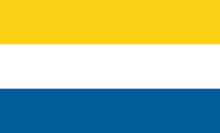

tornionlaaksolaiset (Meänkieli)
| |
|---|---|

Flag of the Torne Valley
| |
| Regions with significant populations | |
| 30,000–150,000 (est.)[1] | |
| Languages | |
| Meänkieli, Finnish and Swedish | |
| Religion | |
| Lutheranism (Laestadianism) | |
| Related ethnic groups | |
| Kvens, Finns | |
Tornedalians (Meänkieli: tornionlaaksolaiset; Finnish: tornionjokilaaksolaiset; Swedish: tornedalingar) are a linguistic minority native to the Torne Valley (Meänmaa) region in northern Sweden and Finland.[2] Tornedalians are since year 2000 a recognized national minority in Sweden.[3] Tornedalians generally divide themselves into three distinct groups: Tornedalians, Kvens, and Lantalaiset.[2]
Tornedalians are generally thought to be descended from the ancient Kvens, first mentioned by Ohthere of Hålogaland in 890, though recountings of Tornedalian history often begin with the birkarls who are first mentioned in 1328 in a legal hearing by the Swedish Drots Knut Jonsson over disputes with the Hälsings who the birkarls claimed were encroaching on their lands.[4][5] The birkarls were through the 14th to the 17th century slowly incorporated into the Swedish state, with the establishing of Christianity beginning in the 1400s though some pagan burials continued until the early 1600s.[6][5]
Following the Treaty of Fredrikshamn between Sweden and Russia in 1809, all Swedish lands east of the Torne and Muonio rivers were ceded to Russia as the Grand Duchy of Finland. As a result, the Finnish-speaking communities on the western side were now officially separated from those on the eastern side of the border, which later also led to divergence of dialect and the language known as Meänkieli.[7] Though the now split region continued to be culturally homogenous and the border had little impact on people's everyday life for some time after.[8]
Tornedalians were the targets of extensive so-called "racial biology" and swedification policies. In the early- to mid-1900s, Herman Lundborg and others from the State Institute for Racial Biology performed skull measurements on Tornedalians, with Lundborg performing the first measurements in 1913. At the same time, speaking Finnish in schools was banned in parts of the country, including the Torne Valley.[7] This ban was only revoked by the Riksdag in 1957.[9]
In 2000, a new law went into effect recognising the Tornedalians as an official national minority and Meänkieli as an official minority language. A truth and reconciliation commission on historical discrimination against the population was appointed in 2020, and made its final report on 15 May 2023.[9] In both 2020 and 2023, STR-T, the National Association of Swedish Tornedalians have demanded the Swedish government to investigate their status as an indigenous people in accordance with ILO 169 though both times the Swedish government has denied to do so.[10]
Sweden does not distinguish minority groups in population censuses, but the number of people who identify themselves as "Tornedalians" is usually estimated to be between 30,000 and 150,000. Estimates are complicated by the fact that the remote and sparsely-populated Tornedalen area has been particularly struck by the 20th-century urbanisation and unemployment. In 2006, a large radio survey about Finnish/Meänkieli speakers was conducted in Sweden. The result was that 469,000 individuals in Sweden claimed to understand or speak Finnish and/or Meänkieli. Those who can speak or understand Meänkieli are estimated to be 150,000–175,000.
Bengt Pohjanen is a Tornedalian author who has written the first novel in Meänkieli, the language of the Meänmaa.[11] He has written dramas, screenplays, songs and opera. He is trilingual in his writing.
The novel Populärmusik från Vittula (Popular Music from Vittula) (2000) by the Tornedalian author Mikael Niemi became very popular both in Sweden and in Finland. It is composed of colourful stories of everyday life in the Tornedalian town of Pajala. The novel has been adapted for several stage productions, and as a film in 2004.
The flag is a horizontal tricolour of yellow, white and blue.